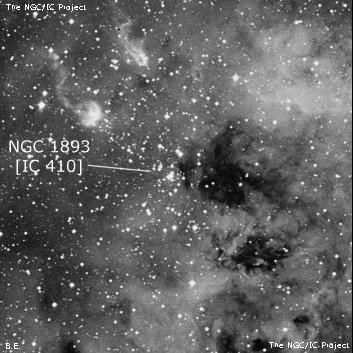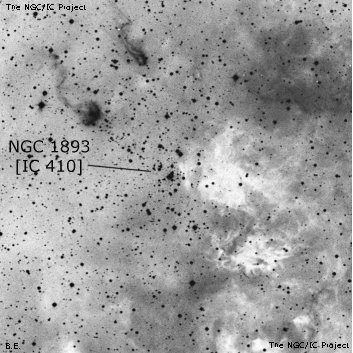NGC/IC Project Restoration Effort
(This is a very very beta version)
NGC1893


Basic Information
Location and Magnitude
Right Ascension: 5:22:45.6
Declination: +33:24:52
Constellation: AUR
Visual Magnitude: 7.5
Historic Information
Discoverer: Herschel J.
Year of discovery: 1827
Discovery aperture: 18.3
Observational
Summary description: Cl, L, Ri, lC
Sub-type: II2mn
Corwin's Notes
=====
NGC 1893 is a cluster found by JH. As noted by Brent Archinal in "Star
Clusters" and in an email from Wolfgang Steinicke, it is embedded in a large,
faint nebulosity found by Max Wolf and listed as IC 410. JH apparently did
not see the nebula as he makes no note of it. While Wolf noted stars in his
nebula, his note is primarily concerned with the nebula and not the stars.
So, applying the two numbers to both objects is incorrect, though it has been
done often in the 20th century catalogues.
Another curiosity here is JH's RA. Steve Gottlieb has found that it is three
minutes of time too large (the declination is correct); this carried over into
the GC and NGC. I've found that Reinmuth in Die Nebel-Herschel of 1926 flags
his position of the cluster as corrected from the NGC, so this may well be the
reason that all the current catalogues have the correct RA.
-----
In the sweep (number 51 on 22 January 1827), the minutes of the clock reading
is "25::", and the reduced minute of RA is "14:". JH gives no reason for the
uncertainty, and he did not carry it over into his 1833 list. So, the GC and
NGC appear to have a position with a typical uncertainty, while the actual RA
is indeed 3 minutes of time smaller.
Steve's Notes
=====
NGC 1893
24" (1/4/14): at 200x, this bright, young cluster contains 80-100 stars, with the richest portion forming a large boomerang-shaped region extending 12'x5' N-S. The outline is slightly concave to the west and convex to the east with a narrow denser region in the center with several pairs and trios. NGC 1893 is the core of the Aur OB2 association and contains a number of massive O-type stars including 9th mag O4-type HD 242908 at the NW tip of the "boomerang" and 9.4-mag HD 24296 (O6-type star) forming the SW tip of the outline. In the rich central region is 9.8-mag O7-type HD 242935, and the brightest component of the multiple star Bu 887, with two fainter companions at ~10" separation. Just 1.4' NNW of this triple is a 14" of mag 10.4/11.4 stars, with brighter component BD+33 1025, an O8-type star. Also 2.4' SE is a 10" pair of mag 11.4/12.4 stars. In addition, many other stars appear to be arranged in pairs and strings, so the cluster has a striking appearance. These and other hot O and B-type stars in the cluster ionize the large emission nebula IC 410, which is quite impressive using a UHC filter (see separate description).
The cometary "Tadpoles" nebulae Simeis 130 and 129, which contain recently minted stars, lie on the east end of the cluster. The "head" of Simeis 130 was immediately picked up at 200x as a very small, fairly high surface brightness knot with at least one star involved. At 260x and 375, two very close "stars" oriented WSW-ENE were embedded in the glow, with the ENE object quasi-stellar (would not focus to a sharp point) and perhaps a very tight pair. Although impressive on images, there was no sign of the wavy tail extending from the "head" towards the NE. Mag 9.1 BD+33 1028, 3' E of Simeis 130, along with a 6' group of a half-dozen mag 10-11 stars, were visually detached to the NE of the main cluster.
13.1" (2/25/84): about 40 mostly faint stars, elongated N-S in poor transparency.Ê Located within a triangle of three mag 8 stars.Ê The emission nebula IC 410 is involved.



